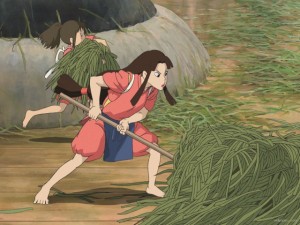The first time I saw Hayao Miyazaki’s Spirited Away I was in BJ’s, a wholesale club store like Costco or Sam’s Club that my parents frequented for our weekly groceries. I never loved anime as much as some of my friends, but the moment I saw Haku, a shape-shifting river spirit, snake through the sky as a silvery-white dragon on the discount big-screen TV, I was enthralled. While the eight-year-old Chihiro slaved away in the bath house for the gods, confronted the monstrous No Face, and freed her parents from Yubaba’s curse, my physical reality melted away. If my parents came to check on me or if they left me to stand in front of the screens, I don’t remember. It doesn’t matter: I finished watching the film in the store and bought the DVD a few weeks later.
Ever since then I’ve been madly in love with Miyazaki’s and Studio Ghibli’s work. While Miyazaki certainly has not escaped the critical eyes of scholars[1], his films are the only place I can mute the incessant whirl of my own academic ruminations, in gender and animation, and simply relax into the story. In a genre often dominated by tales of young boys, Miyazaki’s films more often than not include a diverse cast of female characters that are refreshingly three-dimensional.
Spirited Away is no exception. Chihiro is given a complete narrative arc, transforming from a “spoiled crybaby” (as Yubaba calls her) to a compassionate and courageous young girl. Whereas in other animated films the young boy is the one to embark on an amazing adventure with a female supporting character, Chihiro’s is the one to embark on a terrifying and weird journey into the Spirit World, thus inverting the narrative trope. There she meets Lin, a tough-talking employee who takes a shine to Chihiro, Yubaba, the bath house’s ostentatious owner, and Zeniba, Yubaba’s kinder, more austere twin sister. It is also worth noting that none of these three women, or any of the characters in the film, are engaged in a heterosexual romantic relationship of any kind. While Chihiro does form a close friendship with the dragon Haku and she spends a sizeable chunk of the film worrying about him, their relationship remains strictly platonic.
Contrast this to other female-led films where a male romantic interest must at least be implied, as in Disney’s Mulan, or where the lack of a male romantic interest is cause for celebration, as in Pixar’s Brave: the beautiful princess waiting, seeking, or avoiding her prince charming remains a central narrative for young girls today. In the end, how the princess chooses to interact with her male counterpart hardly matters: the point remains that she is defined by her relationship (or lack of a relationship) to him. Chihiro’s story disrupts the usual princess narrative entirely. As an entirely ordinary girl, Chihiro is a reflection of the girls in Miyazaki’s audience. She demonstrates exactly how they can embark upon and survive the bizarre twists and turns they might encounter in their own lives. Furthermore, her deep but platonic friendship with Haku offers girls a means of relating to the opposite sex beyond the romantic relationship seen in these princess films[2]
That Miyazaki and his studio have granted so much screen time to so many rich, compelling female leads is nothing short of a deep, long, easy breath of fresh air. More than mere love interests or foils, his female protagonists, supporting characters, and antagonists are brilliant, evil, cunning, intelligent, shy, flirtatious, selfish, and compassionate, free to fall in love or not as they see fit. They appear in twos and threes and fours, talking about something other than men[3]. They’re unique and real and human. All that is left, then, is for me to say “thank you”: thank you, Miyazaki and Studio Ghibli, for creating a safe space in which I can relax before going back out to dismantle our society’s androcentrism cel by cel.
[1] The Anime Art of Hayao Miyazaki by Dani Cavallaro and Hayao Miyazaki, Master of Japanese Animation: Film, Themes, Artistry by Helen McCarthy come immediately to mind.
[2] For a far more comprehensive discussion of Miyazaki’s female protagonists compared to their Western counterparts, please see Christine Hoff Kramer’s essay “Disney, Miyazaki, and Feminism: Why Western Girls Need Japanese Animation” – http://www.christinehoffkraemer.com/miyazaki.html.
[3] This allows most of Miyazaki’s films to pass the Bechdel Test, a rough and dirty litmus test devised by Alison Bechdel in her comic Dykes to Watch Out For, where a piece of fiction must have two women who speak and speak about something other than a man. Feminist scholars and media critics frequently use the test to determine if film merely reinforces the male gender bias that permeates mass media or if it genuinely creates a space for women’s voices.
Kodi Maier is a second year PhD student at the University of Hull. Their thesis focuses on the Disney Princess franchise’s evolution and how the franchise impacts female gender roles among young girls in the United States. Outside of gender and animation, they are also interested in studying comics, popular culture, and other “geeky” subjects. They love novelty socks and colorful tattoos.


I need help on a presentaition about the history of Totoro and I already know about the siyama incident but can you give me some extra facts you know about studio ghilbli or totoro